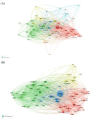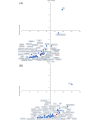Telemedicine Research Trends in 2001-2022 and Research Cooperation Between China and Other Countries Before and After the COVID-19 Pandemic: Bibliometric Analysis
- PMID: 39213010
- PMCID: PMC11399753
- DOI: 10.2196/40801
Telemedicine Research Trends in 2001-2022 and Research Cooperation Between China and Other Countries Before and After the COVID-19 Pandemic: Bibliometric Analysis
Abstract
Background: Advancements in technology have overcome geographical barriers, making telemedicine, which offers remote emergency services, healthcare, and medication guidance, increasingly popular. COVID-19 restrictions amplified its global importance by bridging distances.
Objective: This study aimed to analyze Chinese and global literature data, present new global telemedicine research trends, and clarify the development potential, collaborations, and deficiencies in China's telemedicine research.
Methods: We conducted bibliometrics and network analyses on relevant documents from the Web of Science database from 2001 to 2022. Data collection was completed on October 30, 2023. Considering COVID-19's impact, 2020 was used as a baseline, dividing the data into 2 periods: 2001-2019 and 2020-2022. The development potential was determined based on publication trends. An international coauthorship network analysis identified collaboration statuses and potential. Co-occurrence analysis was conducted for China and the world.
Results: We identified 25,333 telemedicine-related research papers published between 2001 and 2022, with a substantial increase during the COVID-19 period (2020-2022), particularly in China (1.93-fold increase), moving its global publication rank from tenth to sixth. The United States, the United Kingdom, and Australia contributed 62.96% of the literature, far ahead of China's 3.90%. Globally, telemedicine research increased significantly post-2020. Between 2001 and 2019, the United States and Australia were central in coauthor networks; post-2020, the United States remained the largest node. Network hubs included the United States, the United Kingdom, Australia, and Canada. Keyword co-occurrence analysis revealed 5 global clusters from 2001 to 2019 (system technology, health care applications, mobile health, mental health, and electronic health) and 2020 to 2022 (COVID-19, children's mental health, artificial intelligence, digital health, and rehabilitation of middle-aged and older adults). In China, the research trends aligned with global patterns, with rapid growth post-2020. From 2001 to 2019, China cooperated closely with Indonesia, India, Japan, Taiwan, and South Korea. From 2020 to 2022, cooperation expanded to Japan, Singapore, Malaysia, and South Korea, as well as Saudi Arabia, Egypt, South Africa, Ghana, Lebanon, and other African and Middle Eastern countries. Chinese keyword co-occurrence analysis showed focus areas in system technology, health care applications, mobile health, big data analysis, and electronic health (2001-2019) and COVID-19, artificial intelligence, digital health, and mental health (2020-2022). Although psychology research increased, studies on children's mental health and middle-aged and older adults' rehabilitation were limited.
Conclusions: We identified the latest trends in telemedicine research, demonstrating its significant potential in China and providing directions for future development and collaborations in telemedicine research.
Keywords: bibliometric analysis; co-occurrence analysis; coauthorship analysis; network analysis; telehealth; telemedicine.
©Hanlin Feng, Karin Kurata, Jianfei Cao, Kageyama Itsuki, Makoto Niwa, Atsushi Aoyama, Kota Kodama. Originally published in the Interactive Journal of Medical Research (https://www.i-jmr.org/), 30.08.2024.
Conflict of interest statement
Conflicts of Interest: KK has received research donations for Ritsumeikan University from Kumagaya Gumi, Sumitomo Life Insurance, Merge system, and Pasona. All other authors declare no conflicts of interest.
Figures







References
-
- Sikandar H, Vaicondam Y, Parveen S, Khan N, Qureshi MI. Bibliometric analysis of telemedicine and e-Health literature. Int. J. Onl. Eng. 2021 Nov 29;17(12):52–69. doi: 10.3991/ijoe.v17i12.25483. - DOI
-
- Einthoven W. The telecardiogram. American Heart Journal. 1957;53(4):602–615. doi: 10.1016/0002-8703(57)90367-8. https://www.sciencedirect.com/science/article/abs/pii/0002870357903678 - DOI
LinkOut - more resources
Full Text Sources

